Do you ever feel like there are too many moving parts in your project delivery? You trust your team. You know they’re highly skilled. But you don’t feel like you have the level of oversight you need. Of course, no business owner wants to micro-manage their staff.
So, how can you get quick updates without constantly looking over your project teams’ shoulders?
Say hello to the daily scrum meeting. It’s a daily status meeting of sorts that’s so quick, you don’t even need to sit down.
You may already be adopting Scrum methods in your business and wouldn’t be alone. The 16th State of Agile Report found that 64% of teams adopted Agile to speed up delivery.
Daily scrums, or standups, do this by helping you stay on track and overcome roadblocks early, without the need to be constantly checking in.
In this article, we’ll walk you through the fundamentals of the daily Scrum and show you how to run them step-by-step.
What is Scrum?
The Scrum project management framework is a flexible project management approach that helps you organize work iteratively.
It divides tasks into short cycles, or sprints, that usually go for a few weeks at a time. These sprints keep work focused on high-priority tasks. And because sprints are short, teams can adapt and improve continuously over time.
So, how does the Scrum framework fit within the Agile methodology?
Agile focuses on making agile teams more flexible and improving collaboration. It breaks projects into small parts to make broader Agile principles more practical for all types and sizes of businesses.
What is a Scrum daily meeting (a.k.a standup)?
The daily Scrum is one of the five Scrum ceremonies. These ceremonies give you an easy and routine structure to help you implement Agile in your business and improve how your projects are delivered. These five ceremonies are:
- The sprint planning meeting: The sprint planning meeting is where Scrum teams pick tasks from the refined product backlog and commit to completing them in the upcoming sprint. This process is also known as creating the sprint backlog.
- The daily Scrum: The daily Scrum meeting, known as daily standup meetings, is a short, daily team gathering for Scrum teams. Team members (quickly) review their task progress and goals and bring up any obstacles they’ve run into.
- The sprint review: The sprint review meeting is held after each sprint. The team presents completed work to the customer and key stakeholders for feedback and discusses potential changes or improvements.
- The sprint retrospective: The sprint retrospective is where the entire team reflects on the previous sprint, identifies what went well and areas for improvement, and then comes up with strategies to enhance future performance.
- Backlog refinement: Backlog refinement is a Scrum practice where the team, including the product owners, reviews and refines user stories and items in the product backlog. This way, they're well-defined and ready to go for future sprints.
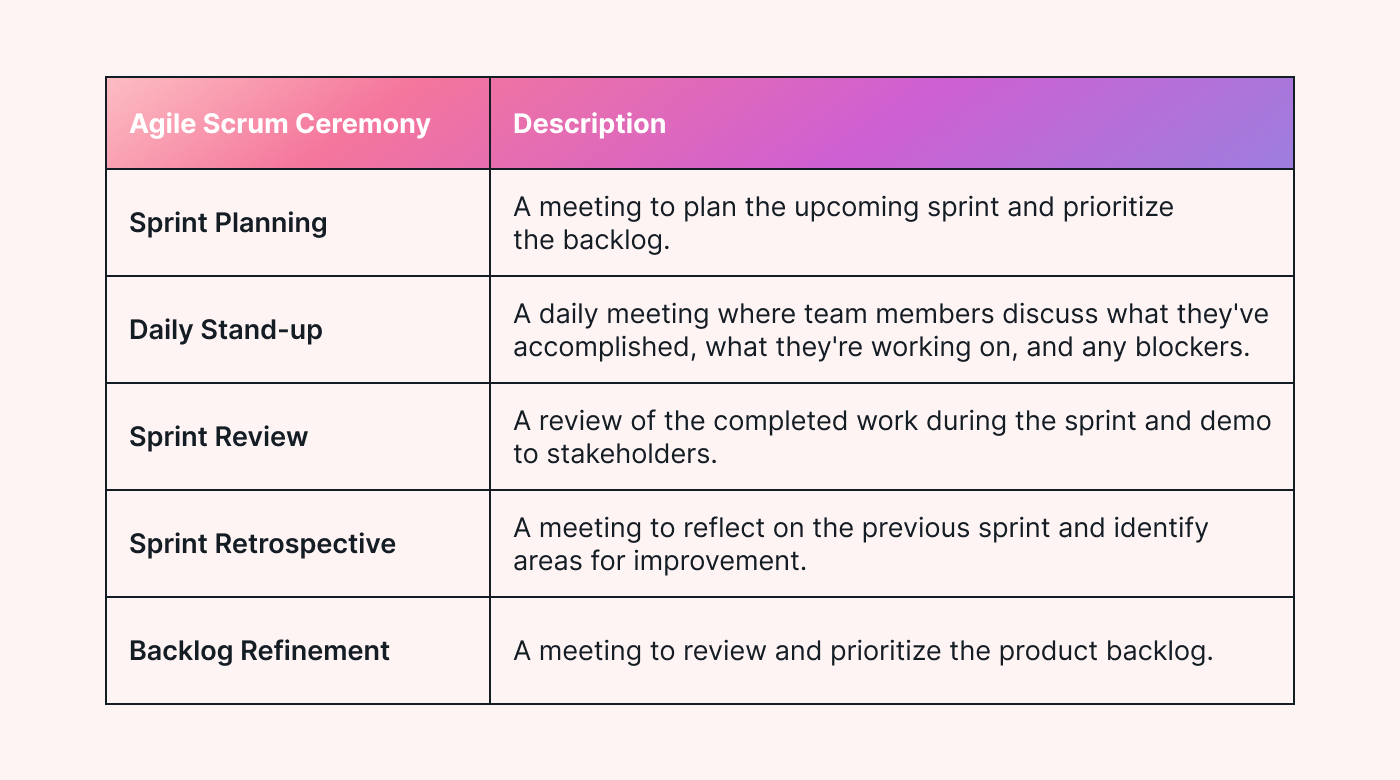 |
These meetings work together in iterative cycles to improve your agile practices and help you get better outcomes more consistently.
But you might wonder, "How can we fit in yet another meeting?"
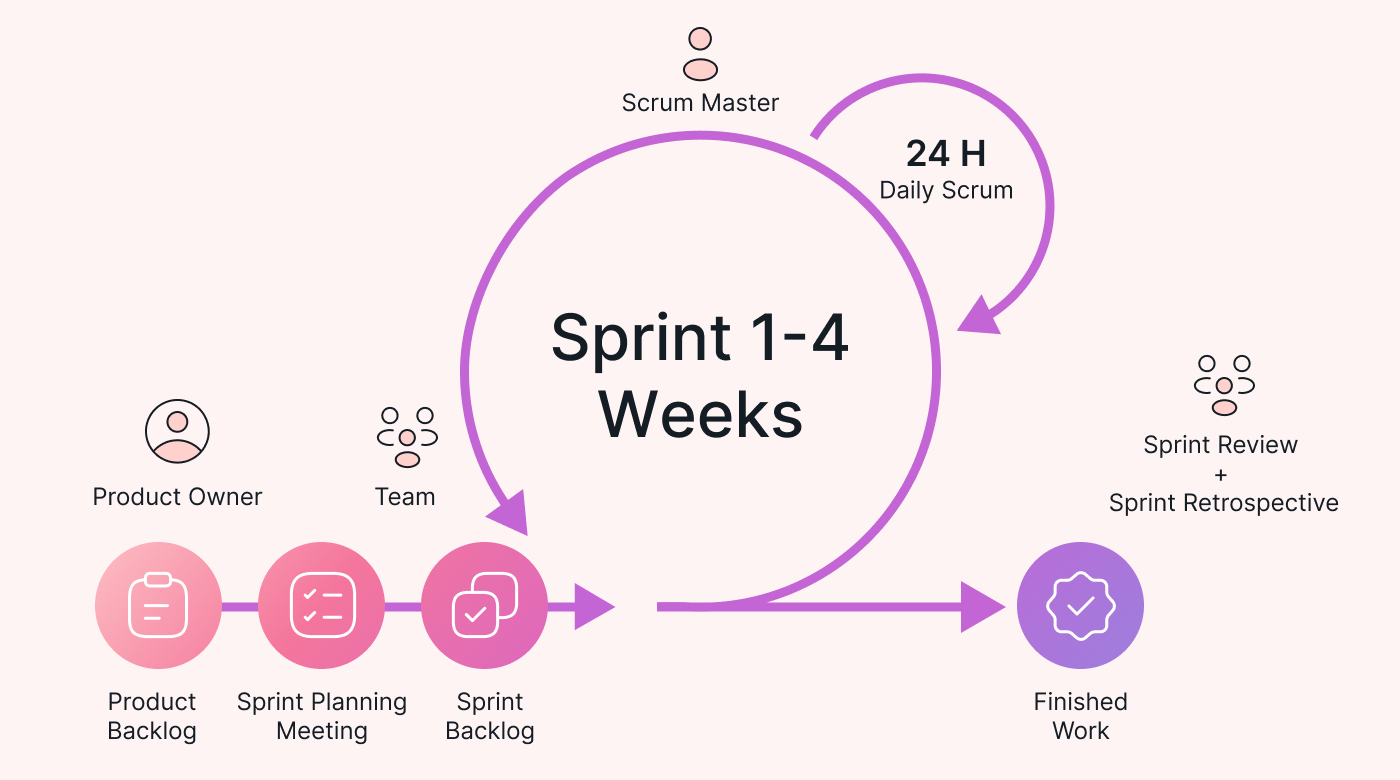 |
The trick lies in making these Agile ceremonies a regular practice. Over time, you'll reduce other check-ins and back-and-forth email chains.
What are the Scrum roles?
In addition to the Agile meetings, there are certain Agile team roles that'll enhance your daily stand-up meetings.
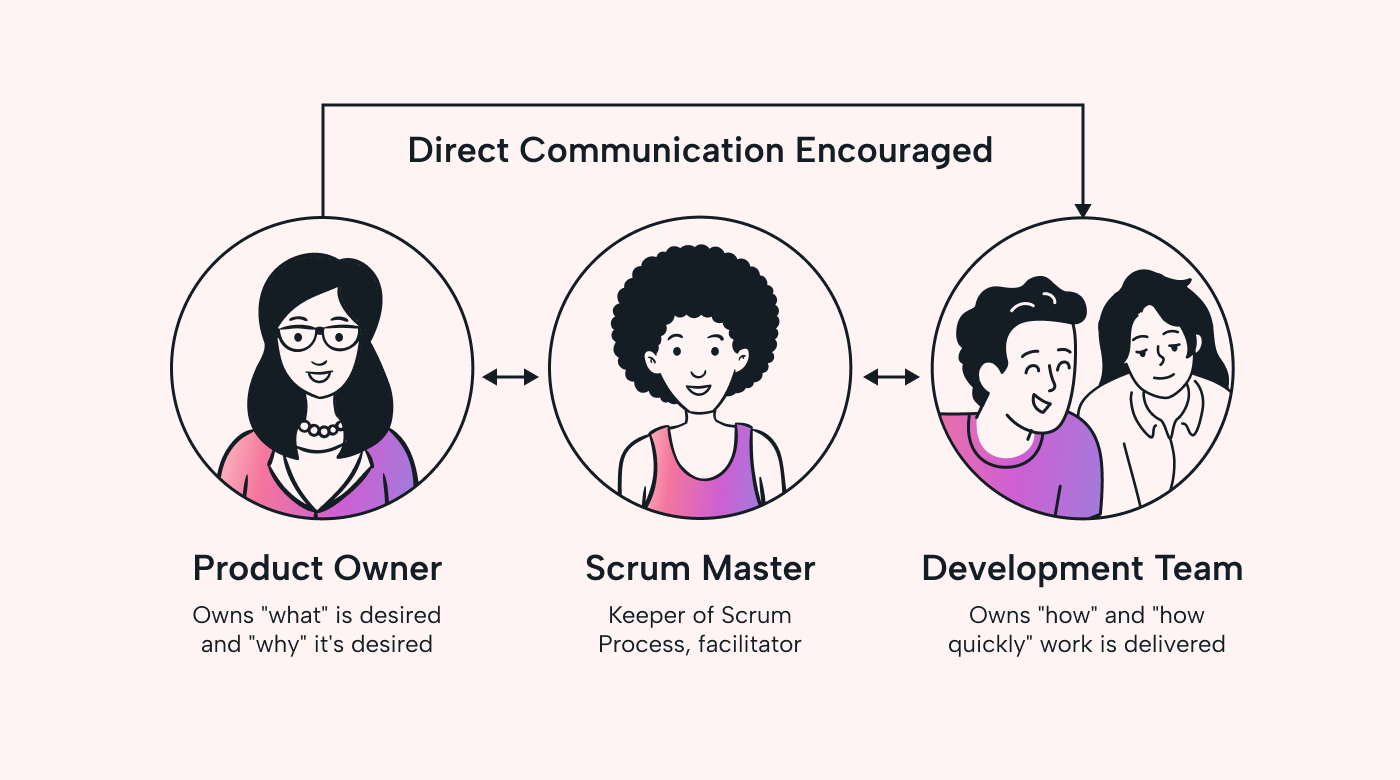 |
- The Scrum master: The Scrum master is a servant leader who helps the team by organizing meetings, coaching others in agile practices, and removing roadblocks.
- The product owner: The product owner is responsible for the product or service, making sure it meets the customers
- The development team: The development or core team is a cross-functional group of people who produce the product or service.
So, who runs the daily standup?
Unlike other ceremonies, the daily standups can have rotating facilitators to keep them fresh.
What is the goal of a daily Scrum?
The daily Scrum is a short daily meeting where the project team shares a quick status update.
The team will plan the work for the day ahead, inform the others about any roadblocks, and provide a small amount of social pressure to keep everyone working at the same pace.
The meetings are kept intentionally short to keep everyone on track and focused.
What is done in the daily Scrum?
The daily Scrum should be 15 minutes and best done first thing in the morning of every work day. It provides some social pressure to keep people committed to their word. When they say something will be done, the next meeting confirms it was done and, if not, why.
Quick and punchy communication
These meetings are intentionally kept short and to the point to keep work moving. This isn’t a time to problem-solve or get into small talk about the weekend. For these meetings to work as intended, conversation is limited to the structure provided: the three questions.
Status updates
Everyone comes prepared to answer three questions. These three questions provide the framework for open and honest discussion in the daily Scrum meetings:
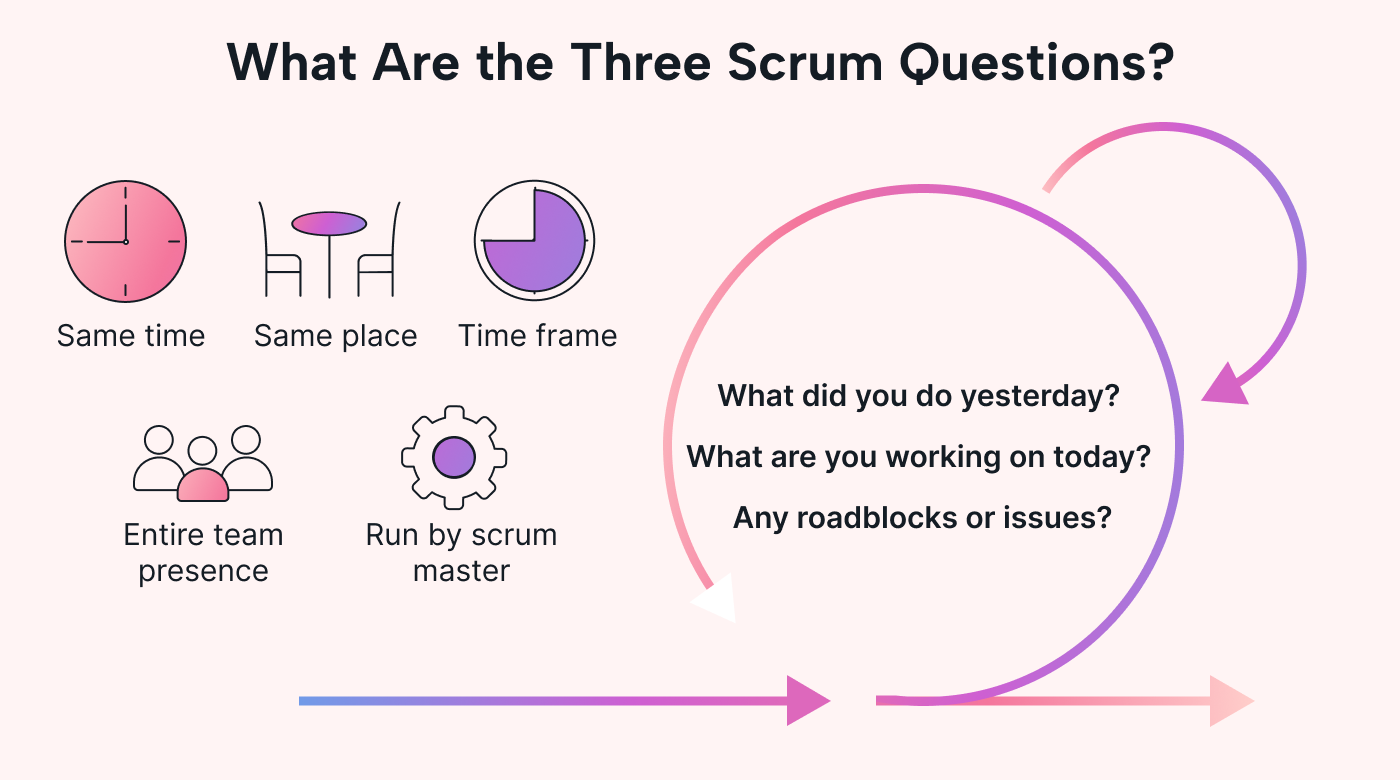 |
1. What did you do yesterday?
This question is designed to elicit progress on tasks.
Each person on the development team provides a clear list of the tasks completed, avoiding adding stories or fluff.
Example: "I did three tasks: wrote two social media posts and updated the project schedule" (rather than "Well, yesterday I needed to do two social media posts, so I created some images in Canva and then…"). Keep it punchy.
2. What are you working on today?
This question helps track the plan for (and ongoing progress of) tasks and helps make sure that team members are actively working on their assigned work.
Answers should be a quick list of the tasks for the day. Team members should be cautious not to overload themselves with too many (or too few) tasks.
Example: "Today, I'm working on drafting an email newsletter, reviewing code, and preparing for the team presentation."
3. Any roadblocks or issues?
This question is crucial for identifying any obstacles getting in the way of progress (and should be addressed promptly).
The responses should be straightforward and focused on the facts. No making excuses or complaining.
Example: "I'm having problems getting access to a specific database for the project. I'll reach out to IT for assistance."
Removing blocks quickly
While this is not a meeting for problem solving, it is a great opportunity to note down any action items to remove blocks your team are experiencing. The key to success in these meetings is to make sure that no one is going into “story mode.”
For example: Status updates should be provided as short bullets, “Yesterday I wrote three blog posts and two social media posts for marketing” and not “Sarah from marketing called and asked if I could help them out by writing two articles on xyz, but I wasn’t really sure what would work, so first I did some research on…”. You can see how quickly your 15-minute meeting can become an hour-long discussion.
A good measure of someone going into a story is if it starts with, “well, I got to work, and then I did this, and then this…”
Just as importantly, if a task isn’t completed on time or there's a roadblock, any discussion should be objective. Pointing fingers is a big no-no, “My blog post is blocked because Mark from design is too slow in getting images out.” Focus instead on the obstacle: The article is written but still requires some images. This then provides Mark the opportunity to provide a status update on the images when it’s his turn.
These are just a few tips for a successful daily Scrum. Here's a checklist you can use to guide yours:
Your checklist for an effective daily Scrum
- Set a regular time and place (preferably first thing in the morning).
- Keep it short, around 15 minutes.
- Stand to encourage brevity (even if everyone is remote).
- Each team member shares three things for each question.
- Focus on problem-solving outside the meeting (if needed).
- Stick to the agenda and avoid unrelated discussions.
- Rotate facilitators to give the team confidence in leading.
- Follow up on action items/blockers after the meeting.
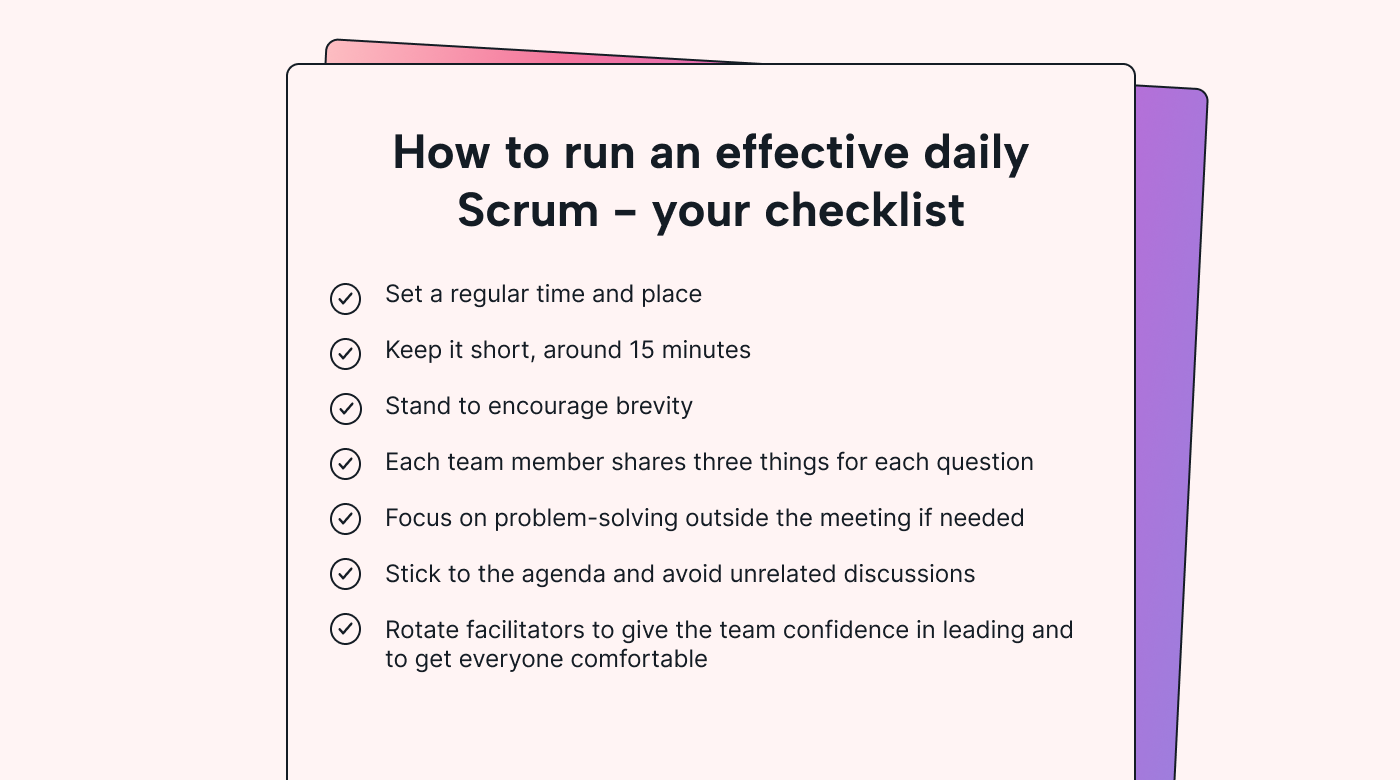 |
Three Pro tips for the most effective daily Scrums
Make those daily Scrums even more efficient by keeping the following in mind:
1. Short, sharp, and shiny
- Keep your standups quick.
- Don’t allow waffle - no stories or excuses - keep to the facts and solutions.
- No interrupting: One person speaking at a time.
2. Nameless, blameless, and shameless
- When talking about roadblocks or unfinished tasks, there should be no naming, shaming, or blaming.
- Work towards solutions quickly and objectively.
- The value of the project is the most important thing - not who did or didn’t do what.
3. Use project management tools
- Keep action items documented in a task tracker like Motion.
- Automate scheduling daily Scrum meetings with a meeting assistant.
- Use snapshots of daily task lists to bring to daily standups.
- Follow up on action items and roadblocks after the meeting by scheduling them in a project board.
What’s next for your daily Scrum?
Say goodbye to overwhelming projects and hello to easy oversight. Get quick updates and build accountability in your team. Win/win! And you don't have to do it alone. Motion has AI-driven automation to take the manual load of managing your projects off.
But don't just take our word for it.
Fifty thousand customers can't be wrong. Take a look at what James, Founder of Practice Owner, had to say.
“Motion helps me feel more relaxed and chill. I don’t have to worry about stuff I’m forgetting. I stick tasks in Motion and forget about them.”
So, what are you waiting for? Try Motion free today!





